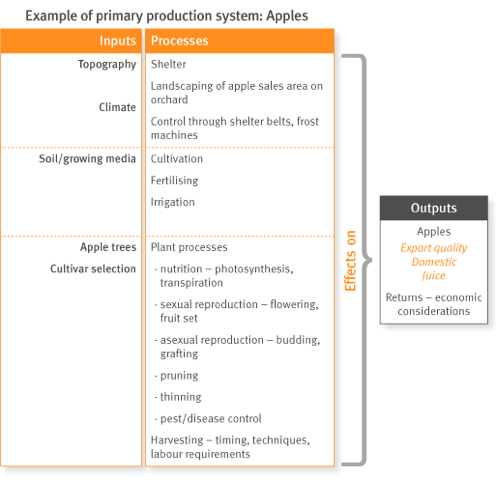Sample programme: Horticultural focus
High-level question
How can an orchardist produce high volumes of high-quality apples for the early market?
Second-level questions
1. Why are apples grown predominantly in this region?
Introducing the context
Suggested time: 7–10 weeks
Resource requirements: Visit to apple orchard, soils investigations and experiments
Consider:
- location: geography, transport, processing facilities, irrigation, and so on
- topography/distribution pattern (local and national)
- climate: sunshine hours, annual rainfall, extreme events, annual and daily temperature, and so on
- soils: properties (texture, structure), modification of properties (through the use of fertilisers, drainage, irrigation).
Possible achievement standards: AS90918, AS90157, AS90919, AS90920.
2. What management practices result in high volumes of high-quality apples?
Developing understanding of aspects of primary production
Suggested time: 12–15 weeks
Resource requirements: Visit to apple orchard, plant growth investigations, and pruning, thinning experiments
Consider:
- cultivar selection: specific cultivar attributes (related to market requirements, climate); genetics; reproductive physiology (including propagation techniques, germination, flowering and fruit set)
- plant growth management: weed control; fertiliser application; soil modification; training (pruning, staking, tying, thinning); irrigation; drainage; spacing, density and orientation of trees
- plant growth physiology: internal and external plant structures (xylem, phloem, leaves, flowers, primary and secondary growth); plant processes (photosynthesis, respiration, transpiration, nutrient uptake, osmosis, germination)
- health and disease management: pest and disease control (including internal and external micro-organisms); loss of production; withholding periods
- environmental management: protection from frost and wind damage (frost pots, shelter provision).
Possible achievement standards: AS90918, AS90157, AS90923, AS90924.
3. What impact does the production of high volumes of high-quality apples have on the environment?
Exploring the environmental impacts of apple growing
Suggested time: 5–7 weeks
Resource requirements: Visit to apple orchard, investigations and experiments
Consider:
- water management: packing shed practices; spreading of fertiliser, storage, treatment and recycling; runoff; water quality
- soil impacts: compaction from machinery; erosion, runoff; orchard soil management programmes (including organic methods)
- nutrient impacts: fertiliser application rate, frequency, type; nutrient recycling
- chemical impacts: use of weed control; use of biological control, integrated pest management (ipm)
- production impacts: burning of prunings; noise (frost protection, bird scarers); smell; increased transport; visual (for example, shelter belts)
- landscaping considerations: the provision of aesthetically pleasing, ecologically sustainable environment for workers.
Possible achievement standards: AS90160, AS90922, plus aspects of AS90918, AS90157, AS90919, AS90923, AS90924.
4. How will the production of high volumes of high-quality apples impact on returns to the orchardist?
Revisiting concepts covered in the learning programme
Suggested time: 3–5 weeks
Resource requirements: visit to apple orchard, results from investigations and experiments throughout the course
Consider:
- production costs: the costs of different management practices for environmental control (frost)
- labour availability: the need for skilled, reliable labour, the provision of housing, and so on
- management decisions: suitability of practices used in the production process, based on economic considerations such as those relating to the environment.
Possible achievement standards AS90157, AS90919, AS90920, (also business studies and tourism [ecotourism]).
Note
When planning internal assessments, take into consideration how they fit into the wider school programme, and ensure that students have a balance of internal and external assessment.

Apple diagram
Last updated December 5, 2011
TOP


